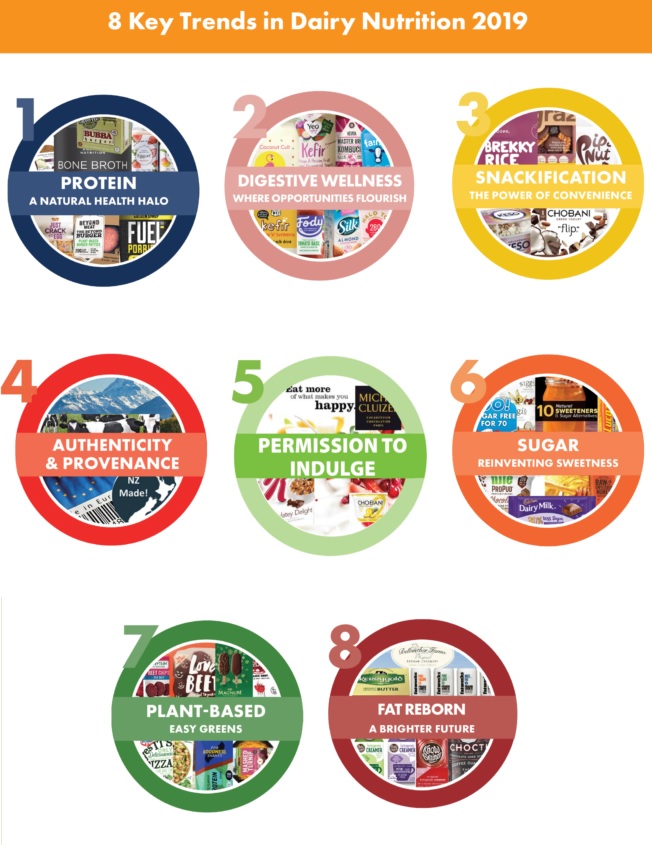Successful dairy companies embrace the most powerful consumer trends.
Dairy has long been one of the most creative categories in the supermarket, creating new types of products and bringing new benefits to the consumer. But there is an increasingly wide gap between the performance of companies who understand the key consumer trends and make them part of their strategy – and those who do not.
“Key to success in dairy nutrition is that alongside your volume business you should incubate new products that are trend-connected – lower volume but usually higher margin,” said food industry consultant Julian Mellentin, author of the recent report, 8 Key Trends in Dairy Nutrition. “These are the seeds from which future great trees can grow.”
Among the companies who have embraced this strategy are:
Graham’s Dairy in Scotland, which has used NPD connected to the Protein, Provenance and Snackification trends to make itself a strong, value-added company – as well as a commodity liquid milk seller.
Valio Dairy in Finland has connected to the Plant-Based dairy alternatives trend, despite being a farmer-owned dairy co-operative. Valio sees an opportunity that can improve farmer returns and keep challengers out of the chiller cabinet.
General Mills, a global giant, is innovating in ways that would not have been expected from ‘Big Food’ even two or three years ago. Once the market leader in the US yoghurt market, Yoplait was late to enter the Greek race and as a result still lags Chobani and Danone, and sales are down by 20%. In 2017 it debuted Oui by Yoplait, a ‘French-style’ yoghurt sold in single-serve glass pots. The brand is unlike anything that this volume-driven, low-priced brand had done before, combining provenance with artisanal style packaging. Within a year it was on track to be a $100 million-brand.

Why is understanding how trends can drive strategy so important?
“In the 21st century brands are no longer in control – they are all like corks tossed on the ocean of powerful consumer trends,” said Mellentin. “If the trends are against you, it’s better to acknowledge the new reality and work with it than to wish it weren’t so, or to tell yourself that the consumer will come back round to your way of thinking. Against the powerful forces of the free market, resistance is useless.”
And for big companies who think their size insulates them against these forces, Mellentin has a strong message. “Often senior management teams think of strategy primarily in terms of big volumes and big market shares, and this has become a trap in which companies live in a low-price, commoditised market and struggle to maintain margins,” he said. “Being a big company is not always the source of competitive advantage that it was.”
The most successful brands and ingredients are those that deliver against multiple trends, as the following brands – three of the biggest successes of the last five years – show:
- Halo Top ice-cream is less sugar but also more protein
- Fairlife Milk is less sugar, but also lactose-free and more protein
- P3 protein packs are about snacking and protein
A trend should not be overlooked just because it’s at this stage very small. In fact, one of the biggest lessons of the past 25 years, according to Mellentin, is that what’s “wacky and weird” has a habit of becoming normal, successful and even everyday. When that happens, you almost always find that because it’s connected to key trends, he said, pointing to A2 Milk as an example.
“When this digestive wellness milk debuted in Australia back in 2004, it was regarded as eccentric, lacking in science and certain to fail,” said Mellentin. “But now, A2 Milk is the world’s most profitable dairy company.”
8 Key Trends in Dairy Nutrition 2019: Strategies and case studies is a 100-page report written as a practical guide to help dairy executives plan strategy and new product development. It sets out:
- how the trends are developing, and how they will develop in the future
- what strategies companies are following to connect to the trends (to help you figure out your own options)
- what’s emerging that’s going to be important
- what’s going to stick around for the long-term
- where best to place your bets
Julian Mellentin is one of the world’s few international specialists in the business of food, nutrition and health. He is director of New Nutrition Business, which provides case studies and analysis of success and failure in the global nutrition business and is used by more than 1,700 corporate subscribers in 42 countries. New Nutrition Business is a research and consultancy company with an expert focus on the business of food and health since 1995. It has offices in the United States, Europe, and New Zealand and affiliates in Japan and South Korea. Find out more at: www.new-nutrition.com.



